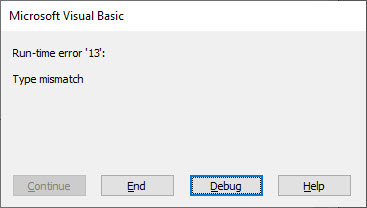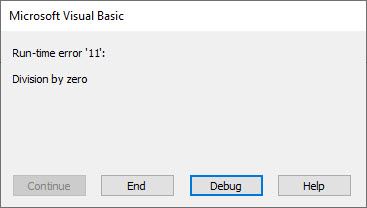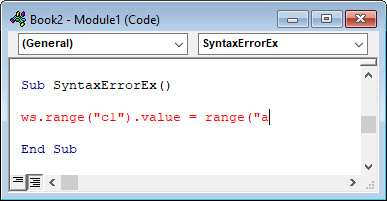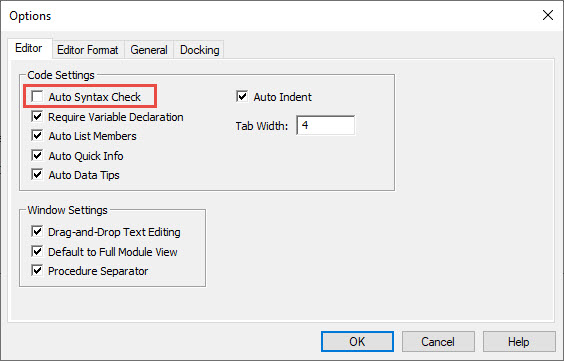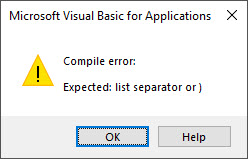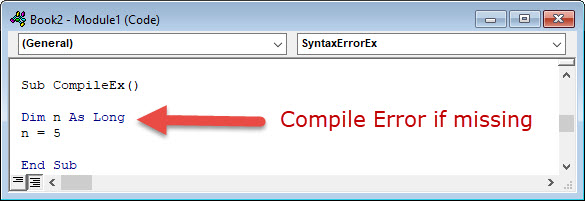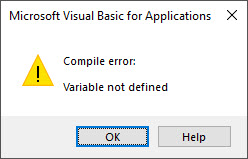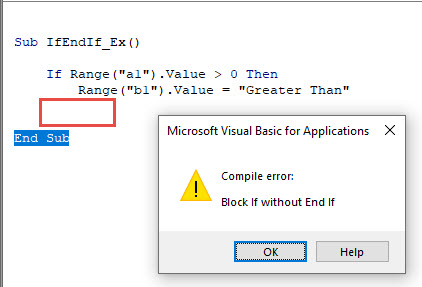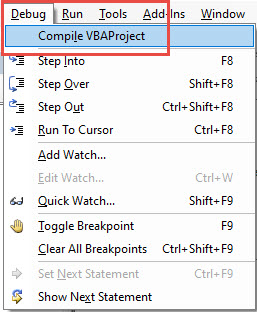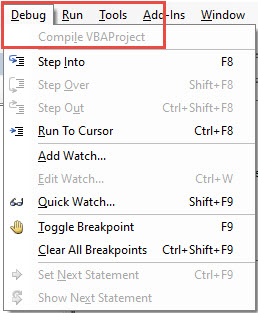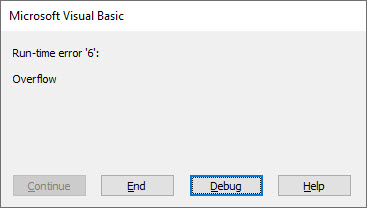| title | keywords | f1_keywords | ms.prod | ms.assetid | ms.date | ms.localizationpriority |
|---|---|---|---|---|---|---|
|
Elements of run-time error handling |
vbaac10.chm5186924 |
vbaac10.chm5186924 |
access |
a0e06a1e-2709-aa51-92d0-340788a31a8a |
09/21/2018 |
medium |
Elements of run-time error handling
Errors and error handling
When you are programming an application, you need to consider what happens when an error occurs. An error can occur in your application for one of two of reasons. First, some condition at the time the application is running makes otherwise valid code fail. For example, if your code attempts to open a table that the user has deleted, an error occurs. Second, your code may contain improper logic that prevents it from doing what you intended. For example, an error occurs if your code attempts to divide a value by zero.
If you’ve implemented no error handling, then Visual Basic halts execution and displays an error message when an error occurs in your code. The user of your application is likely to be confused and frustrated when this happens. You can forestall many problems by including thorough error-handling routines in your code to handle any error that may occur.
When adding error handling to a procedure, you should consider how the procedure will route execution when an error occurs. The first step in routing execution to an error handler is to enable an error handler by including some form of the On Error statement within the procedure. The On Error statement directs execution in event of an error. If there’s no On Error statement, Visual Basic simply halts execution and displays an error message when an error occurs.
When an error occurs in a procedure with an enabled error handler, Visual Basic doesn’t display the normal error message. Instead it routes execution to an error handler, if one exists. When execution passes to an enabled error handler, that error handler becomes active. Within the active error handler, you can determine the type of error that occurred and address it in the manner that you choose. Access provides three objects that contain information about errors that have occurred, the ADO Error object, the Visual Basic Err object, and the DAO Error object.
Routing execution when an error occurs
An error handler specifies what happens within a procedure when an error occurs. For example, you may want the procedure to end if a certain error occurs, or you may want to correct the condition that caused the error and resume execution. The On Error and Resume statements determine how execution proceeds in the event of an error.
On Error statement
The On Error statement enables or disables an error-handling routine. If an error-handling routine is enabled, execution passes to the error-handling routine when an error occurs.
There are three forms of the On Error statement: On Error GoTo label, On Error GoTo 0, and On Error Resume Next. The On Error GoTo label statement enables an error-handling routine, beginning with the line on which the statement is found. You should enable the error-handling routine before the first line at which an error could occur. When the error handler is active and an error occurs, execution passes to the line specified by the label argument.
The line specified by the label argument should be the beginning of the error-handling routine. For example, the following procedure specifies that if an error occurs, execution passes to the line labeled:
Function MayCauseAnError() ' Enable error handler. On Error GoTo Error_MayCauseAnError . ' Include code here that may generate error. . . Error_MayCauseAnError: . ' Include code here to handle error. . . End Function
The On Error GoTo 0 statement disables error handling within a procedure. It doesn’t specify line 0 as the start of the error-handling code, even if the procedure contains a line numbered 0. If there’s no On Error GoTo 0 statement in your code, the error handler is automatically disabled when the procedure has run completely. The On Error GoTo 0 statement resets the properties of the Err object, having the same effect as the Clear method of the Err object.
The On Error Resume Next statement ignores the line that causes an error and routes execution to the line following the line that caused the error. Execution isn’t interrupted. Use the On Error Resume Next statement if you want to check the properties of the Err object immediately after a line at which you anticipate an error will occur, and handle the error within the procedure rather than in an error handler.
Resume statement
The Resume statement directs execution back to the body of the procedure from within an error-handling routine. You can include a Resume statement within an error-handling routine if you want execution to continue at a particular point in a procedure. However, a Resume statement isn’t necessary; you can also end the procedure after the error-handling routine.
There are three forms of the Resume statement. The Resume or Resume 0 statement returns execution to the line at which the error occurred. The Resume Next statement returns execution to the line immediately following the line at which the error occurred. The Resume label statement returns execution to the line specified by the label argument. The label argument must indicate either a line label or a line number.
You typically use the Resume or Resume 0 statement when the user must make a correction. For example, if you prompt the user for the name of a table to open, and the user enters the name of a table that doesn’t exist, you can prompt the user again and resume execution with the statement that caused the error.
You use the Resume Next statement when your code corrects for the error within an error handler, and you want to continue execution without rerunning the line that caused the error. You use the Resume label statement when you want to continue execution at another point in the procedure, specified by the label argument. For example, you might want to resume execution at an exit routine, as described in the following section.
Exiting a procedure
When you include an error-handling routine in a procedure, you should also include an exit routine, so that the error-handling routine will run only if an error occurs. You can specify an exit routine with a line label in the same way that you specify an error-handling routine.
For example, you can add an exit routine to the example in the previous section. If an error doesn’t occur, the exit routine runs after the body of the procedure. If an error occurs, then execution passes to the exit routine after the code in the error-handling routine has run. The exit routine contains an Exit statement.
Function MayCauseAnError() ' Enable error handler. On Error GoTo Error_MayCauseAnError . ' Include code here that may generate error. . . Exit_MayCauseAnError: Exit Function Error_MayCauseAnError: . ' Include code to handle error. . . ' Resume execution with exit routine to exit function. Resume Exit_MayCauseAnError End Function
Handling errors in nested procedures
When an error occurs in a nested procedure that doesn’t have an enabled error handler, Visual Basic searches backward through the calls list for an enabled error handler in another procedure, rather than simply halting execution. This provides your code with an opportunity to correct the error within another procedure. For example, suppose Procedure A calls Procedure B, and Procedure B calls Procedure C. If an error occurs in Procedure C and there’s no enabled error handler, Visual Basic checks Procedure B, then Procedure A, for an enabled error handler. If one exists, execution passes to that error handler. If not, execution halts and an error message is displayed.
Visual Basic also searches backward through the calls list for an enabled error handler when an error occurs within an active error handler. You can force Visual Basic to search backward through the calls list by raising an error within an active error handler with the Raise method of the Err object. This is useful for handling errors that you don’t anticipate within an error handler. If an unanticipated error occurs, and you regenerate that error within the error handler, then execution passes back up the calls list to find another error handler, which may be set up to handle the error.
For example, suppose Procedure C has an enabled error handler, but the error handler doesn’t correct for the error that has occurred. Once the error handler has checked for all the errors that you’ve anticipated, it can regenerate the original error. Execution then passes back up the calls list to the error handler in Procedure B, if one exists, providing an opportunity for this error handler to correct the error. If no error handler exists in Procedure B, or if it fails to correct for the error and regenerates it again, then execution passes to the error handler in Procedure A, assuming one exists.
To illustrate this concept in another way, suppose that you have a nested procedure that includes error handling for a type mismatch error, an error which you’ve anticipated. At some point, a division-by-zero error, which you haven’t anticipated, occurs within Procedure C. If you’ve included a statement to regenerate the original error, then execution passes back up the calls list to another enabled error handler, if one exists. If you’ve corrected for a division-by-zero error in another procedure in the calls list, then the error will be corrected. If your code doesn’t regenerate the error, then the procedure continues to run without correcting the division-by-zero error. This in turn may cause other errors within the set of nested procedures.
In summary, Visual Basic searches back up the calls list for an enabled error handler if:
-
An error occurs in a procedure that doesn’t include an enabled error handler.
-
An error occurs within an active error handler. If you use the Raise method of the Err object to raise an error, you can force Visual Basic to search backward through the calls list for an enabled error handler.
Getting information about an error
After execution has passed to the error-handling routine, your code must determine which error has occurred and address it. Visual Basic and Access provide several language elements that you can use to get information about a specific error. Each is suited to different types of errors. Since errors can occur in different parts of your application, you need to determine which to use in your code based on what errors you expect.
The language elements available for error handling include:
-
Err object
-
ADO Error object and Errors collection
-
DAO Error object and Errors collection
-
AccessError method
-
Error event
Err object
The Err object is provided by Visual Basic. When a Visual Basic error occurs, information about that error is stored in the Err object. The Err object maintains information about only one error at a time. When a new error occurs, the Err object is updated to include information about that error instead.
To get information about a particular error, you can use the properties and methods of the Err object:
- The Number property is the default property of the Err object; it returns the identifying number of the error that occurred.
- The Err object’s Description property returns the descriptive string associated with a Visual Basic error.
- The Clear method clears the current error information from the Err object.
- The Raise method generates a specific error and populates the properties of the Err object with information about that error.
The following example shows how to use the Err object in a procedure that may cause a type mismatch error:
Function MayCauseAnError() ' Declare constant to represent likely error. Const conTypeMismatch As Integer = 13 On Error GoTo Error_MayCauseAnError . ' Include code here that may generate error. . . Exit_MayCauseAnError: Exit Function Error_MayCauseAnError: ' Check Err object properties. If Err = conTypeMismatch Then . ' Include code to handle error. . . Else ' Regenerate original error. Dim intErrNum As Integer intErrNum = Err Err.Clear Err.Raise intErrNum End If ' Resume execution with exit routine to exit function. Resume Exit_MayCauseAnError End Function
Note that in the preceding example, the Raise method is used to regenerate the original error. If an error other than a type mismatch error occurs, execution will be passed back up the calls list to another enabled error handler, if one exists.
The Err object provides you with all the information you need about Visual Basic errors. However, it doesn’t give you complete information about Access errors or Access database engine errors. Access and Data Access Objects (DAO)) provide additional language elements to assist you with those errors.
Error object and Errors collection
The Error object and Errors collection are provided by ADO and DAO. The Error object represents an ADO or DAO error. A single ADO or DAO operation may cause several errors, especially if you are performing DAO ODBC operations. Each error that occurs during a particular data access operation has an associated Error object. All the Error objects associated with a particular ADO or DAO operation are stored in the Errors collection, the lowest-level error being the first object in the collection and the highest-level error being the last object in the collection.
When a ADO or DAO error occurs, the Visual Basic Err object contains the error number for the first object in the Errors collection. To determine whether additional ADO or DAO errors have occurred, check the Errors collection. The values of the ADO Number or DAO Number properties and the ADO Description or DAO Description properties of the first Error object in the Errors collection should match the values of the Number and Description properties of the Visual Basic Err object.
AccessError method
Use the Raise method of the Err object to generate a Visual Basic error that hasn’t actually occurred and determine the descriptive string associated with that error. However, you can’t use the Raise method to generate a Access error, an ADO error, or a DAO error. To determine the descriptive string associated with an Access error, an ADO error, or a DAO error that hasn’t actually occurred, use the AccessError method.
Error event
Use the Error event to trap errors that occur on an Access form or report. For example, if a user tries to enter text in a field whose data type is Date/Time, the Error event occurs. If you add an Error event procedure to an Employees form, then try to enter a text value in the HireDate field, the Error event procedure runs.
The Error event procedure takes an integer argument, DataErr. When an Error event procedure runs, the DataErr argument contains the number of the Access error that occurred. Checking the value of the DataErr argument within the event procedure is the only way to determine the number of the error that occurred. The Err object isn’t populated with error information after the Error event occurs. Use the value of the DataErr argument together with the AccessError method to determine the number of the error and its descriptive string.
[!NOTE]
The Error statement and Error function are provided for backward compatibility only. When writing new code, use the Err and Error objects, the AccessError function, and the Error event for getting information about an error.
About the contributors
Link provided by 
- Handling Access Errors with VBA
UtterAccess is the premier Microsoft Access wiki and help forum.
See also
- Access for developers forum
- Access help on support.office.com
- Access forums on UtterAccess
- Access developer and VBA programming help center (FMS)
- Access posts on StackOverflow
[!includeSupport and feedback]
In this Article
- VBA Errors Cheat Sheet
- Errors
- VBA Error Handling
- VBA On Error Statement
- On Error GoTo 0
- On Error Resume Next
- Err.Number, Err.Clear, and Catching Errors
- On Error GoTo Line
- VBA IsError
- If Error VBA
- VBA Error Types
- Runtime Errors
- Syntax Errors
- Compile Errors
- Debug > Compile
- OverFlow Error
- Other VBA Error Terms
- VBA Catch Error
- VBA Ignore Error
- VBA Throw Error / Err.Raise
- VBA Error Trapping
- VBA Error Message
- VBA Error Handling in a Loop
- VBA Error Handling in Access
VBA Errors Cheat Sheet
Errors
On Error – Stop code and display error
On Error Goto 0
On Error – Skip error and continue running
On Error Resume Next
On Error – Go to a line of code [Label]
On Error Goto [Label]
Clears (Resets) Error
On Error GoTo –1
Show Error number
MsgBox Err.Number
Show Description of error
MsgBox Err.Description
Function to generate own error
Err.Raise
See more VBA “Cheat Sheets” and free PDF Downloads
VBA Error Handling
VBA Error Handling refers to the process of anticipating, detecting, and resolving VBA Runtime Errors. The VBA Error Handling process occurs when writing code, before any errors actually occur.
VBA Runtime Errors are errors that occur during code execution. Examples of runtime errors include:
- Referencing a non-existent workbook, worksheet, or other object (Run-time Error 1004)
- Invalid data ex. referencing an Excel cell containing an error (Type Mismatch – Run-time Error 13)
- Attempting to divide by zero
VBA On Error Statement
Most VBA error handling is done with the On Error Statement. The On Error statement tells VBA what to do if it encounters an error. There are three On Error Statements:
- On Error GoTo 0
- On Error Resume Next
- On Error GoTo Line
On Error GoTo 0
On Error GoTo 0 is VBA’s default setting. You can restore this default setting by adding the following line of code:
On Error GoTo 0When an error occurs with On Error GoTo 0, VBA will stop executing code and display its standard error message box.
Often you will add an On Error GoTo 0 after adding On Error Resume Next error handling (next section):
Sub ErrorGoTo0()
On Error Resume Next
ActiveSheet.Shapes("Start_Button").Delete
On Error GoTo 0
'Run More Code
End SubOn Error Resume Next
On Error Resume Next tells VBA to skip any lines of code containing errors and proceed to the next line.
On Error Resume NextNote: On Error Resume Next does not fix an error, or otherwise resolve it. It simply tells VBA to proceed as if the line of code containing the error did not exist. Improper use of On Error Resume Next can result in unintended consequences.
A great time to use On Error Resume Next is when working with objects that may or may not exist. For example, you want to write some code that will delete a shape, but if you run the code when the shape is already deleted, VBA will throw an error. Instead you can use On Error Resume Next to tell VBA to delete the shape if it exists.
On Error Resume Next
ActiveSheet.Shapes("Start_Button").Delete
On Error GoTo 0Notice we added On Error GoTo 0 after the line of code containing the potential error. This resets the error handling.
In the next section we’ll show you how to test if an error occurred using Err.Number, giving you more advanced error handling options.
VBA Coding Made Easy
Stop searching for VBA code online. Learn more about AutoMacro — A VBA Code Builder that allows beginners to code procedures from scratch with minimal coding knowledge and with many time-saving features for all users!
Learn More
Err.Number, Err.Clear, and Catching Errors
Instead of simply skipping over a line containing an error, we can catch the error by using On Error Resume Next and Err.Number.
Err.Number returns an error number corresponding with the type of error detected. If there is no error, Err.Number = 0.
For example, this procedure will return “11” because the error that occurs is Run-time error ’11’.
Sub ErrorNumber_ex()
On Error Resume Next
ActiveCell.Value = 2 / 0
MsgBox Err.Number
End SubError Handling with Err.Number
The true power of Err.Number lies in the ability to detect if an error occurred (Err.Number <> 0). In the example below, we’ve created a function that will test if a sheet exists by using Err.Number.
Sub TestWS()
MsgBox DoesWSExist("test")
End Sub
Function DoesWSExist(wsName As String) As Boolean
Dim ws As Worksheet
On Error Resume Next
Set ws = Sheets(wsName)
'If Error WS Does not exist
If Err.Number <> 0 Then
DoesWSExist = False
Else
DoesWSExist = True
End If
On Error GoTo -1
End FunctionNote: We’ve added a On Error GoTo -1 to the end which resets Err.Number to 0 (see two sections down).
With On Error Resume Next and Err.Number, you can replicate the “Try” & “Catch” functionality of other programming languages.
On Error GoTo Line
On Error GoTo Line tells VBA to “go to” a labeled line of code when an error is encountered. You declare the Go To statement like this (where errHandler is the line label to go to):
On Error GoTo errHandlerand create a line label like this:
errHandler:Note: This is the same label that you’d use with a regular VBA GoTo Statement.
Below we will demonstrate using On Error GoTo Line to Exit a procedure.
On Error Exit Sub
You can use On Error GoTo Line to exit a sub when an error occurs.
You can do this by placing the error handler line label at the end of your procedure:
Sub ErrGoToEnd()
On Error GoTo endProc
'Some Code
endProc:
End Subor by using the Exit Sub command:
Sub ErrGoToEnd()
On Error GoTo endProc
'Some Code
GoTo skipExit
endProc:
Exit Sub
skipExit:
'Some More Code
End SubErr.Clear, On Error GoTo -1, and Resetting Err.Number
After an error is handled, you should generally clear the error to prevent future issues with error handling.
After an error occurs, both Err.Clear and On Error GoTo -1 can be used to reset Err.Number to 0. But there is one very important difference: Err.Clear does not reset the actual error itself, it only resets the Err.Number.
What does that mean? Using Err.Clear, you will not be able to change the error handling setting. To see the difference, test out this code and replace On Error GoTo -1 with Err.Clear:
Sub ErrExamples()
On Error GoTo errHandler:
'"Application-defined" error
Error (13)
Exit Sub
errHandler:
' Clear Error
On Error GoTo -1
On Error GoTo errHandler2:
'"Type mismatch" error
Error (1034)
Exit Sub
errHandler2:
Debug.Print Err.Description
End SubTypically, I recommend always using On Error GoTo -1, unless you have a good reason to use Err.Clear instead.
VBA On Error MsgBox
You might also want to display a Message Box on error. This example will display different message boxes depending on where the error occurs:
Sub ErrorMessageEx()
Dim errMsg As String
On Error GoTo errHandler
'Stage 1
errMsg = "An error occured during the Copy & Paste stage."
'Err.Raise (11)
'Stage 2
errMsg = "An error occured during the Data Validation stage."
'Err.Raise (11)
'Stage 3
errMsg = "An error occured during the P&L-Building and Copy-Over stage."
Err.Raise (11)
'Stage 4
errMsg = "An error occured while attempting to log the Import on the Setup Page"
'Err.Raise (11)
GoTo endProc
errHandler:
MsgBox errMsg
endProc:
End SubHere you would replace Err.Raise(11) with your actual code.
VBA IsError
Another way to handle errors is to test for them with the VBA ISERROR Function. The ISERROR Function tests an expression for errors, returning TRUE or FALSE if an error occurs.
Sub IsErrorEx()
MsgBox IsError(Range("a7").Value)
End SubVBA Programming | Code Generator does work for you!
If Error VBA
You can also handle errors in VBA with the Excel IFERROR Function. The IFERROR Function must be accessed by using the WorksheetFunction Class:
Sub IfErrorEx()
Dim n As Long
n = WorksheetFunction.IfError(Range("a10").Value, 0)
MsgBox n
End SubThis will output the value of Range A10, if the value is an error, it will output 0 instead.
VBA Error Types
Runtime Errors
As stated above:
VBA Runtime Errors are errors that occur during code execution. Examples of runtime errors include:
- Referencing a non-existent workbook, worksheet, or other object
- Invalid data ex. referencing an Excel cell containing an error
- Attempting to divide by zero
You can “error handle” runtime errors using the methods discussed above.
Syntax Errors
VBA Syntax Errors are errors with code writing. Examples of syntax errors include:
- Mispelling
- Missing or incorrect punctuation
The VBA Editor identifies many syntax errors with red highlighting:
The VBA Editor also has an option to “Auto Syntax Check”:
When this is checked, the VBA Editor will generate a message box alerting you syntax errors after you enter a line of code:
I personally find this extremely annoying and disable the feature.
Compile Errors
Before attempting to run a procedure, VBA will “compile” the procedure. Compiling transforms the program from source code (that you can see) into executable form (you can’t see).
VBA Compile Errors are errors that prevent the code from compiling.
A good example of a compile error is a missing variable declaration:
Other examples include:
- For without Next
- Select without End Select
- If without End If
- Calling a procedure that does not exist
Syntax Errors (previous section) are a subset of Compile Errors.
AutoMacro | Ultimate VBA Add-in | Click for Free Trial!
Debug > Compile
Compile errors will appear when you attempt to run a Procedure. But ideally, you would identify compile errors prior to attempting to run the procedure.
You can do this by compiling the project ahead of time. To do so, go to Debug > Compile VBA Project.
The compiler will “go to” the first error. Once you fix that error, compile the project again. Repeat until all errors are fixed.
You can tell that all errors are fixed because Compile VBA Project will be grayed out:
OverFlow Error
The VBA OverFlow Error occurs when you attempt to put a value into a variable that is too large. For example, Integer Variables can only contain values between -32,768 to 32,768. If you enter a larger value, you’ll receive an Overflow error:
Instead, you should use the Long Variable to store the larger number.
Other VBA Error Terms
VBA Catch Error
Unlike other programming languages, In VBA there is no Catch Statement. However, you can replicate a Catch Statement by using On Error Resume Next and If Err.Number <> 0 Then. This is covered above in Error Handling with Err.Number.
AutoMacro | Ultimate VBA Add-in | Click for Free Trial!
VBA Ignore Error
To ignore errors in VBA, simply use the On Error Resume Next statement:
On Error Resume NextHowever, as mentioned above, you should be careful using this statement as it doesn’t fix an error, it just simply ignores the line of code containing the error.
VBA Throw Error / Err.Raise
To through an error in VBA, you use the Err.Raise method.
This line of code will raise Run-time error ’13’: Type mismatch:
Err.Raise (13)VBA Error Trapping
VBA Error Trapping is just another term for VBA Error Handling.
VBA Error Message
A VBA Error Message looks like this:
When you click ‘Debug’, you’ll see the line of code that is throwing the error:
AutoMacro | Ultimate VBA Add-in | Click for Free Trial!
VBA Error Handling in a Loop
The best way to error handle within a Loop is by using On Error Resume Next along with Err.Number to detect if an error has occurred (Remember to use Err.Clear to clear the error after each occurrence).
The example below will divide two numbers (Column A by Column B) and output the result into Column C. If there’s an error, the result will be 0.
Sub test()
Dim cell As Range
On Error Resume Next
For Each cell In Range("a1:a10")
'Set Cell Value
cell.Offset(0, 2).Value = cell.Value / cell.Offset(0, 1).Value
'If Cell.Value is Error then Default to 0
If Err.Number <> 0 Then
cell.Offset(0, 2).Value = 0
Err.Clear
End If
Next
End SubVBA Error Handling in Access
All of the above examples work exactly the same in Access VBA as in Excel VBA.
Function DelRecord(frm As Form)
'this function is used to delete a record in a table from a form
On Error GoTo ending
With frm
If .NewRecord Then
.Undo
Exit Function
End If
End With
With frm.RecordsetClone
.Bookmark = frm.Bookmark
.Delete
frm.Requery
End With
Exit Function
ending:
End
End Function
-
Обработка ошибок на этапе выполнения
Как
тщательно не проверялся бы код, на этапе
его выполнения неизбежно возникают
ошибки. Попытка деления на ноль – это
типичный пример ошибки времени выполнения.
В Access обработка ошибок выполняется с
помощью инструкции On Error. Имеется три
вида инструкций On Error:
-
On Error GoTo Метка –
осуществляет переход на строку с меткой
(Метка) при возникновении произвольной
ошибки на этапе выполнения. Обычная
часть кода, обрабатывающая ошибки,
помещается в корпус процедуры. После
обработки ошибки можно либо вызвать
повторение той части кода, где произошла
ошибка, либо проигнорировать ошибку и
продолжить выполнение последующих
инструкций. Для возвращения на строку
с ошибкой используется ключевое слово
Resume. -
On
Error Resume Next – игнорирует ошибку и
продолжает выполнение последующих
инструкций. -
On
Error GoTo 0 отключает обработку ошибок.
После
обработки первой ошибки инструкция On
Error GoTo Метка продолжает выполняться для
всех последующих ошибок, пока не
закончится выполнение данной процедуры
либо обработка ошибок не будет явно
отключена инструкцией On Error GoTo 0. Если
нет обработки какой-то ошибки или
обработка выключена, то при возникновении
необработанной ошибки приложение сразу
же выдаст сообщение об ошибке и прекратит
работу.
Если
процедура обработки некоторого события
создается с помощью мастера, то он
автоматически дополняет процедуру
кодом обработки ошибок.
Private
Sub MyID_DblClick(Cancel As Integer)
On
Error GoTo Err_MyID_DblClick
Текст
процедуры
Exit_MyID_DblClick:
Exit
Sub
Err_MyID_DblClick:
MsgBox
Err.Description
Resume
Exit_MyID_DblClick
End
Sub
Объект
Err содержит информацию об ошибках
выполнения и обычно используется вместе
со структурой Select Case, чтобы определить,
какое действие предпринять в зависимости
от кода ошибки.
Select
Case Err
Case
58 To 76
Call
FileError- процедура обработки ошибок работы
с файлами
Case
281 To 297
Call
DDEError — процедура для обработки ошибок
DDE
Case
340 To 344
Call
ArrayError — процедура
ошибок
массивов
End
Select
Err=0
— отключение обработки необработанных
ошибок.
-
Работа с объектами и коллекциями
В
VBA можно работать с объектами и коллекциями
Access, библиотекой доступа к данным DAO
(Data Access Objects), библиотекой прямого доступа
к данным баз данных ODBC (ODBC Direct), библиотекой
доступа к данным ADO (ActiveX Data Objects) и другими
библиотеками. В Access, DAO и ADO все объекты
расположены внутри коллекций и доступны
в VBA. Каждый объект имеет свойства и
методы. Все библиотеки организованы в
виде иерархии объектов. Объекты имеют
коллекции (семейства) подчиненных
объектов и т.д. В Access имеется 8 базовых
объектов; их иерархия представлена на
Рис. 12.
Объекты
MS
Access:
-
Application – активное
приложение; -
Control
– элемент управления; -
DoCmd
– объект вызова макрокоманд в VBA коде; -
Form
– открытая форма; -
Module
– объект, ссылающийся на стандартные
модули; -
Reference
– объект, содержащий ссылки на объекты; -
Report
– открытый отчет; -
Screen
– ссылка на экран;
Названия
семейств формируются путем возведения
в множественное число названия
соответствующего объекта. В свою очередь
большинство объектов имеют присоединенные
коллекции свойств (Properties),
а формы и отчеты – коллекции разделов
и т.д. Так как все объекты в Access хранятся
внутри иерархически связанных коллекций,
то доступ к объекту на нижней ступени
иерархии можно получить, указав все
имена коллекций, разделенных точкой,
начиная от корневого объекта. Например,
Application.Forms(«Заказы»).Controls(0).Properties(0).
Большинство коллекций, к примеру,
коллекции форм и отчетов, являются
глобальными. Тогда к объекту этой
коллекции можно обращаться напрямую:
Forms(«Заказы») или Forms!Заказы.
Рис. 12. Иерархия
объектов Access
Поскольку
библиотека DAO всегда поставляется с
Access,
рассмотрим ее структуру и основные
методы более подробно (смотри Рис. 13).
Объекты
библиотеки DAO:
Database
– открытая база данных;
DBEngine
– ссылка на Microsoft Jet (ядро БД);
Error
– объект ошибок;
Field
– поле в таблицах, запросах, динамических
наборах и т.д.;
Index
– индекс;
Parameter
– параметр запроса;
QueryDef
– сохранённый запрос;
Recordset
– динамический набор данных;
Relation
– связь между таблицами;
TableDef
– сохраненная таблица;
Workspace
– активная сессия.
Рис. 13. Иерархия
объектов DAO
В
программах на VBA имеется набор свойств
объектов, которые возвращают ссылки на
подчиненные объекты:
Me
– ссылка на активную форму или отчет
(доступна в присоединенном модуле);
ActiveControl
– ссылка на активный элемент управления;
ActiveForm
– ссылка на активную форму (доступна в
объекте Screen);
ActiveReport
– ссылка на активный отчет (доступна в
объекте Screen);
Application
– ссылка на открытое приложение;
Parent
– ссылка на родительский объект, т.е.
на коллекцию;
DBEngine
–
возвращает
ссылку на Application.
Работа
с записями и полями
Применить
фильтрацию, изменить значение какого-либо
поля в базовом наборе данных либо даже
сменить базовый набор можно непосредственно
с помощью свойств самой формы и элементов
управления. Например:
Me![Полная
цена] = Me![Цена]
* Me![Количество]
Me.Filter
= «[Адрес] Like
‘*» & Me![ПолеУсловияПоиска]
& «*'»
Me.FilterOn
= True
Если
есть желание читать и менять данные в
некотором поле базового набора, но не
видеть его на экране, то достаточно
поместить элемент управления Поле
на форму и задать свойство Visible
в False.
Но прямой доступ к базовому набору в
Access
невозможен. Можно лишь создать динамическую
копию базового набора и синхронизировать
все производимые действия с ней с базовым
набором самой формы. Для прямого доступа
к записям и полям используется объект
Recordset. Имеются четыре типа Recordset объектов
– table,
dynaset,
snapshot
и forwarrd-only:
-
Table:
Может быть создан только на основе
существующей или присоединенной
таблицы. Предоставляет доступ ко всем
методам и свойствам таблицы, а также к
индексам, что дает намного более быстрый
метод поиска (метод Seek); -
Dynaset
— может быть создан на основе таблицы
или запроса. Позволяет обновлять данные
в многотабличных запросах и в запросах
к внешним БД. Обновление Dynaset
объекта приводит к автоматическому
обновлению всех участвующих в нем
таблиц; -
Snapshot
— создает статическую копию и существует
только в то время, когда он создан.
Последующие изменения таблиц на него
не воздействуют; -
Forward-only
создает статическую копию с просмотром
только в прямом порядке.
Для
создания объекта типа Recordset используется
метод OpenRecordset:
Set
variable = database.OpenRecodset (source [type, options, lockedits]),
или
Set
variable = object.OpenRecodset ( [type, options, lockedits]),
где
database – это
переменная
типа
Database; object – переменная
типа
TableDef или
QueryDef; source – ссылка
на
объект
типа
TableDef или
QueryDef; type – тип
динамического
набора
(может
принимать
следующие
значения:
dbOpenTable, dbOpenDynaset, dbOpenSnspshot dbOpenForwardOnly);
options может
принимать
следующие
значения:
dbAppendOnly, dbReadOnly, dbForwardOnly,
…; lockedits
– аргумент,
определяющий
разрешение
конфликтов
в
многопользовательских
БД
(может
принимать
следующие
значения:
DbReadOnly, dbPessimistic, dbOptimistic). Например:
Dim db As Database
Dim rst As Recordset
Set db = CurrentDb()
Set rst =
db.OpenRecordset(«Клиенты»,
dbOpenDynaset)
Открыть
Recordset можно и основываясь на переменной
типа формы (допустим только для форм,
основанных на таблице или запросе) с
помощью метода RecordsetClone. Метод RecordsetClone
создает динамический набор, основываясь
на свойстве Источник
данных для
формы
Dim
rstOrders As Recordset
Set
rstOrders = Forms![Заказы].RecordsetClone
или
просто Me.RecordsetClone
Recordset
можно создать, также основываясь на
строке SQL
Set rst =
db.OpenRecordset(«SELECT * FROM Товары
WHERE Цена
> 1000», dbOpenDynaset, dbReadOnly)
После
завершения работы с динамическим набором
его необходимо закрыть. Существуют два
общих способа закрытия объектов в VBA.
Первый заключается в вызове метода
Close, второй – в присвоении соответствующей
объектной переменной значения Nothing.
Например,
rst.Close или
Set rst = Nothing.
Recordset
имеет
текущее
приложение
– current position. Для
синхронизации текущего положения
динамического набора с текущей записью
формы можно использовать свойство
Bookmark
(необходимо всегда помнить, что при
обращении к динамическому набору данные
берутся именно из текущей записи). Для
перемещения по динамическому набору
имеется ряд методов: MoveFirst,
MoseLast,
MoveNext,
MovePrevions,
Move[n].
Например:
Dim
rst As Recordset
Set
rst = Me.RecordsetClone
rst.MoveNext
Me.Bookmark
= rst.Bookmark
Для
определения начала и конца набора можно
использовать свойства BOF (before of file –
начало файла) и EOF (end of file – конец файла).
Если в наборе нет записей, то BOF и EOF равны
True. Если в наборе есть записи, то при
открытии курсор обычно устанавливается
на первой записи и BOF и EOF = False. Если курсор
находится перед первой записью, то BOF =
True, и если курсор находится после
последней записи, то EOF = True.
Число
записей в динамическим наборе можно
получить с помощью свойства RecordCount. Это
свойство возвращает реальное число
записей только для динамического набора,
основанного на таблице, т.е. имеющего
тип dbOpenTable. После открытия динамических
наборов любых других типов число записей
в нем будет неизвестно до тех пор, пока
курсор не будет перемещен на последнюю
запись. Для непосредственной проверки
на наличие в наборе записей лучше
проверить свойство EOF. Если EOF будет
равно True, то RecordCount также будет равен 0.
Public
Function RecCount() As Long
Dim
rstCount As Recordset
Dim
dbs As Database
Set
dbs = CurrentDB()
Set
rstCont = dbs.OpenRecordset(«Заказы»)
If
rstCount.Eof Then
RecCount
= 0
Else
rstCount.MoveLast
RecCount
= rstCount.RecordCount
End
If
rstCount.Close
Set
dbs = Nothing
End
Function
Поиск
определенной записи
Для
наборов, основанных на таблице, можно
использовать метод Seek, который ищет
запись, основываясь на сравнении данных
некоторого индекса с заданными значениями
(самый быстрый метод). Для примера запишем
программу, которая будет проверять
дублирование значений ключевого поля
таблицы Клиенты
перед сохранением записи. Для проверки
результатов поиска в объекте Recordset
имеется свойство NoMatch. Если NoMatch равно
False, то запись с заданными условиями
поиска отсутствует в наборе.
Dim
rst As Recordset
Set
rst = CurrentDb.OpenRecordset(«Клиенты»,
dbOpenTable)
rst.Index
= «PrimaryКey»
rst.Seek
«=»,
Me![КодКлиента]
If
Not rst.NoMatch Then
MsgBox
«Клинт с таким табельным номером уже
существует в базе»
DoCmd.GoToControl
«КодКлиента»
End
If
rst.Close
Метод
Seek всегда начинает поиск с начала набора,
поэтому поиск по одному и тому же условию
будет всегда приводить к одной и той же
записи. Для поиска по динамическим
наборам остальных типов можно применять
также методы FindFirst, FindLast, FindNext и
FindPrevions. Например, подсчитаем количество
заказов определенного клиента:
intCount
= 0
rstOrders.FindFirst
«КодКлиента=» & Me![КодКлиента]
Do
While rstOrders.NoMatch
rstOrders.FindNext
«КодКлиента=»
& Me![КодКлиента]
intCount
= intCount + 1
Loop
Для
поиска записей можно также применять
сортировку и фильтрацию. Для сортировки
записей лучше всего открыть новый
динамический набор, основанный на
запросе SQL с оператором ORDER BY. Для
фильтрации можно задать свойство Filter
объекта Recordset и затем обновить набор с
помощью метода OpenRecordset.
Ниже приведен текст программы,
осуществляющей фильтрацию произвольного
набора:
Function
FilterField(rstTemp As Recordset, strField As String, strFilter As
String) As Recordset
rstTemp.Filter
= strField & » = ‘» & strFilter & «‘»
Set
FilterField = rstTemp.OpenRecordset
End
Function
Обновление
динамических наборов
Обновление
данных возможно только при работе с
динамическими наборами типов dbOpenTable и
dbOpenDynaset. Для редактирования некоторой
записи необходимо вначале установить
курсор на ней, перевести динамический
набор в режим редактирования (метод
Edit), а затем сохранить изменения с помощью
метода Update.
rst.Edit
rst![Товар]
= «Pentium
100»
rst![Цена]
= 100
rst.Update
Метод
Cancel
отменяет внесенные изменения. Для
удаления текущей записи существует
метод Delete. Этот метод удаляет запись
без выдачи каких-либо предупреждений
и не меняет положения курсора. Для
перехода на следующую запись необходимо
вызвать метод MoveNext. Для добавления новой
записи служит метод AddNew. После заполнения
новой записи значениями ее необходимо
сохранить с помощью метода Update, потому
как если после добавления новой записи
перейти к другой записи без сохранения
или просто закрыть динамический набор,
то добавляемая запись будет потеряна.
Следующий пример изменяет значения
полей Цена
и Количество
таблицы Заказы,
отфильтрованной для определенного
клиента.
Dim
rst As Recordset
Dim
dbs As Database
Set
dbs = CurrentDb()
Set
rst = dbs.OpenRecordset(«Заказы»,
dbOpenDynaset)
rst.Filter
= «[КодКлиента]=» & Me![Код
клиента]
Set
rst = rst.OpenRecordset
If
Not rst.EOF Then
With
rst
Do
Until .EOF
.Edit
![Цена]
= rst![Цена]
* 1.2
![Количество]
= ![Количество]
* 2
.Update
.MoveNext
Loop
.Close
End
With
End
If
dbs.Close
Работа
с
полями
Получить
доступ
к
значениям
и
свойствам
полей некоторой таблицы можно, открыв
соответствующий динамический набор.
Коллекция полей Fields является коллекцией
по умолчанию для объекта типа Recordset.
Тогда получить доступ к некоторому полю
можно по его имени или по индексу в
коллекции, например: rst.Fields(Field1”),
rst.Fields(4) или rst![Field1]. После получения
ссылки на объект типа Field можно читать
и изменять его свойства, например:
Dim
fld As Field
fld.DefaultValue
= 1
fld.ValidationRule
= «BETWEEN 1 AND 1000»
fld.Value
= 100
Соседние файлы в папке Лабораторный практикум в Access
- #
01.03.2016798.72 Кб118Articles2000.mdb
- #
01.03.2016311.3 Кб117Articles_be_2000.mdb
- #
- #
- #
- #
- #
- #
- #
Избегание условий ошибки
Когда возникает ошибка времени выполнения, хороший код должен ее обрабатывать. Лучшей стратегией обработки ошибок является запись кода, который проверяет условия ошибки и просто избегает выполнения кода, который приводит к ошибке выполнения.
Одним из ключевых элементов сокращения ошибок во время выполнения является запись небольших процедур, которые делают одно . Чем меньше процедур процедур приходится терпеть неудачу, тем проще код в целом — отлаживать.
Избежать ошибки времени выполнения 91 — Объект или С заблокированной переменной блока:
Эта ошибка будет повышена, если объект используется до назначения ссылки. Возможно, у вас есть процедура, которая получает параметр объекта:
Private Sub DoSomething(ByVal target As Worksheet)
Debug.Print target.Name
End Sub
Если target не назначена ссылка, приведенный выше код вызовет ошибку, которую легко избежать, проверяя, содержит ли объект фактическую ссылку на объект:
Private Sub DoSomething(ByVal target As Worksheet)
If target Is Nothing Then Exit Sub
Debug.Print target.Name
End Sub
Если target назначению не присвоена ссылка, то непризнанная ссылка никогда не используется, и ошибка не возникает.
Этот способ раннего выхода из процедуры, когда один или несколько параметров недопустимы, называется предложением охраны .
Избегайте ошибки времени выполнения 9 — Подкласс вне диапазона:
Эта ошибка возникает при доступе к массиву за пределами его границ.
Private Sub DoSomething(ByVal index As Integer)
Debug.Print ActiveWorkbook.Worksheets(index)
End Sub
Учитывая, что индекс больше, чем количество листов в ActiveWorkbook , приведенный выше код вызовет ошибку времени выполнения. Простое предложение охраны может избежать этого:
Private Sub DoSomething(ByVal index As Integer)
If index > ActiveWorkbook.Worksheets.Count Or index <= 0 Then Exit Sub
Debug.Print ActiveWorkbook.Worksheets(index)
End Sub
Большинство ошибок времени выполнения можно избежать, тщательно проверив значения, которые мы используем, прежде чем мы их используем, и разветвляемся на другом пути выполнения, соответственно, используя простой оператор If — в сторожевых предложениях, который не делает предположений и не проверяет параметры процедуры, или даже в тело более крупных процедур.
Оператор Error
Даже с защитными пунктами, один не может реально всегда учитывать все возможные ошибки , которые могут быть подняты в теле процедуры. Оператор On Error GoTo инструктирует VBA перейти к метке линии и ввести «режим обработки ошибок» всякий раз, когда во время выполнения происходит непредвиденная ошибка. После обработки ошибки, код может возобновить обратно в «нормальное» исполнение с помощью Resume ключевое слово.
Линейные метки обозначают подпрограммы : потому что подпрограммы исходят из устаревшего кода BASIC и используют GoSub GoTo и GoSub и Return чтобы вернуться к «основной» процедуре, довольно легко написать жесткий код спагетти, если все не строго структурировано , По этой причине лучше всего:
- процедура имеет одну и только одну подпрограмму обработки ошибок
- подпрограмма обработки ошибок работает только в состоянии ошибки
Это означает, что процедура, которая обрабатывает его ошибки, должна быть структурирована следующим образом:
Private Sub DoSomething()
On Error GoTo CleanFail
'procedure code here
CleanExit:
'cleanup code here
Exit Sub
CleanFail:
'error-handling code here
Resume CleanExit
End Sub
Стратегии обработки ошибок
Иногда вы хотите обрабатывать разные ошибки с помощью разных действий. В этом случае вы будете проверять глобальный объект Err , который будет содержать информацию об ошибке, которая была поднята, и действовать соответственно:
CleanExit:
Exit Sub
CleanFail:
Select Case Err.Number
Case 9
MsgBox "Specified number doesn't exist. Please try again.", vbExclamation
Resume
Case 91
'woah there, this shouldn't be happening.
Stop 'execution will break here
Resume 'hit F8 to jump to the line that raised the error
Case Else
MsgBox "An unexpected error has occurred:" & vbNewLine & Err.Description, vbCritical
Resume CleanExit
End Select
End Sub
В качестве общего руководства рассмотрите возможность включения обработки ошибок для всей подпрограммы или функции и обработайте все ошибки, которые могут возникнуть в пределах ее области действия. Если вам нужно обрабатывать ошибки только в секции небольшого сечения кода — включить и выключить обработку ошибок на одном уровне:
Private Sub DoSomething(CheckValue as Long)
If CheckValue = 0 Then
On Error GoTo ErrorHandler ' turn error handling on
' code that may result in error
On Error GoTo 0 ' turn error handling off - same level
End If
CleanExit:
Exit Sub
ErrorHandler:
' error handling code here
' do not turn off error handling here
Resume
End Sub
Номера строк
VBA поддерживает номера строк в стиле legacy (например, QBASIC). Скрытое свойство Erl можно использовать для идентификации номера строки, которая вызвала последнюю ошибку. Если вы не используете номера строк, Erl только вернет 0.
Sub DoSomething()
10 On Error GoTo 50
20 Debug.Print 42 / 0
30 Exit Sub
40
50 Debug.Print "Error raised on line " & Erl ' returns 20
End Sub
Если вы используете номера строк, но не последовательно, а затем Erl возвращает номер последней строки перед командой, вызвавшей ошибку.
Sub DoSomething()
10 On Error GoTo 50
Debug.Print 42 / 0
30 Exit Sub
50 Debug.Print "Error raised on line " & Erl 'returns 10
End Sub
Имейте в виду, что Erl также имеет только Integer точность и будет бесшумно переполняться. Это означает, что номера строк за пределами целочисленного диапазона дадут неверные результаты:
Sub DoSomething()
99997 On Error GoTo 99999
99998 Debug.Print 42 / 0
99999
Debug.Print Erl 'Prints 34462
End Sub
Номер строки не так актуален, как утверждение, вызвавшее ошибку, и строки нумерации быстро становятся утомительными и не совсем удобны в обслуживании.
Резюме ключевого слова
Подпрограмма обработки ошибок будет либо:
- выполняются до конца процедуры, и в этом случае выполнение возобновляется в процедуре вызова.
- или используйте ключевое слово
Resumeдля возобновления выполнения внутри той же процедуры.
Ключевое слово Resume должно использоваться только в подпрограмме обработки ошибок, потому что если VBA встречает Resume не находясь в состоянии ошибки, возникает ошибка времени выполнения 20 «Возобновить без ошибок».
Существует несколько способов, по которым подпрограмма обработки ошибок может использовать ключевое слово Resume :
-
Resumeиспользуется отдельно, выполнение продолжается в инструкции, вызвавшей ошибку . Если ошибка на самом деле не обрабатывается , прежде чем делать это, то та же ошибка будет поднят снова, и выполнение может войти в бесконечный цикл. -
Resume Nextпродолжает выполнение инструкции сразу после инструкции, вызвавшей ошибку. Если ошибка на самом деле не обрабатывается , прежде чем делать это, то выполнение разрешается продолжать с потенциально недействительными данными, которые могут привести к логическим ошибкам и неожиданному поведению. -
Resume [line label]продолжает выполнение на указанной метке строки (или номер строки, если вы используете номера строк в стиле устаревшего стиля). Обычно это позволяет выполнить некоторый код очистки до того, как будет чисто выйти из процедуры, например, чтобы закрыть соединение с базой данных, прежде чем вернуться к вызывающему.
Вкл.
Сам оператор On Error может использовать ключевое слово Resume чтобы проинструктировать среду выполнения VBA для эффективного игнорирования всех ошибок .
Если ошибка не выполняется до этого, то выполнение разрешено продолжать с потенциально недействительными данными, что может привести к логическим ошибкам и неожиданному поведению .
Вышеупомянутый акцент не может быть особо подчеркнут. On Error Resume Next эффективно игнорирует все ошибки и выталкивает их под ковер . Программа, которая взрывается с ошибкой во время выполнения с учетом недопустимого ввода, — это более эффективная программа, чем программа, которая работает с неизвестными / непреднамеренными данными — будь то только потому, что ошибка намного легче идентифицируется. On Error Resume Next можно легко скрыть ошибки .
Оператор On Error является областью действия процедур — поэтому в данной процедуре обычно должен быть только один , такой оператор On Error .
Однако иногда не удается избежать ошибки, и переключение на подпрограмму обработки ошибок только на Resume Next просто не кажется правильным. В этом конкретном случае утверждение с известным до невозможности может быть обернуто между двумя On Error :
On Error Resume Next
[possibly-failing statement]
Err.Clear 'resets current error
On Error GoTo 0
Команда On Error GoTo 0 сбрасывает обработку ошибок в текущей процедуре, так что любая дополнительная инструкция, вызывающая ошибку времени выполнения , будет необработанной внутри этой процедуры и вместо этого будет переходить в стек вызовов до тех пор, пока она не будет захвачена активным обработчиком ошибок. Если в стеке вызовов нет активного обработчика ошибок, он будет рассматриваться как необработанное исключение.
Public Sub Caller()
On Error GoTo Handler
Callee
Exit Sub
Handler:
Debug.Print "Error " & Err.Number & " in Caller."
End Sub
Public Sub Callee()
On Error GoTo Handler
Err.Raise 1 'This will be handled by the Callee handler.
On Error GoTo 0 'After this statement, errors are passed up the stack.
Err.Raise 2 'This will be handled by the Caller handler.
Exit Sub
Handler:
Debug.Print "Error " & Err.Number & " in Callee."
Resume Next
End Sub
Пользовательские ошибки
Часто при написании специализированного класса вы хотите, чтобы он поднимал свои собственные конкретные ошибки, и вам понадобится чистый способ для кода пользователя / вызова для обработки этих пользовательских ошибок. Оптимальным способом достижения этого является определение специального типа Enum :
Option Explicit
Public Enum FoobarError
Err_FooWasNotBarred = vbObjectError + 1024
Err_BarNotInitialized
Err_SomethingElseHappened
End Enum
Используя встроенную константу vbObjectError пользовательские коды ошибок не перекрываются с зарезервированными / существующими кодами ошибок. Необходимо явно указать только первое значение перечисления, поскольку базовое значение каждого члена Enum 1 больше, чем предыдущий элемент, поэтому базовое значение Err_BarNotInitialized неявно является vbObjectError + 1025 .
Повышение собственных ошибок времени выполнения
Ошибка выполнения может быть повышена с Err.Raise оператора Err.Raise , поэтому пользовательская ошибка Err_FooWasNotBarred может быть повышена следующим образом:
Err.Raise Err_FooWasNotBarred
Метод Err.Raise также может принимать пользовательские параметры Description и Source — по этой причине рекомендуется также определять константы для хранения каждого пользовательского описания ошибки:
Private Const Msg_FooWasNotBarred As String = "The foo was not barred."
Private Const Msg_BarNotInitialized As String = "The bar was not initialized."
А затем создайте выделенный частный метод для повышения каждой ошибки:
Private Sub OnFooWasNotBarredError(ByVal source As String)
Err.Raise Err_FooWasNotBarred, source, Msg_FooWasNotBarred
End Sub
Private Sub OnBarNotInitializedError(ByVal source As String)
Err.Raise Err_BarNotInitialized, source, Msg_BarNotInitialized
End Sub
После этого реализация класса может просто вызвать эти специализированные процедуры для повышения ошибки:
Public Sub DoSomething()
'raises the custom 'BarNotInitialized' error with "DoSomething" as the source:
If Me.Bar Is Nothing Then OnBarNotInitializedError "DoSomething"
'...
End Sub
Клиентский код может обрабатывать Err_BarNotInitialized как и любую другую ошибку, внутри своей собственной подпрограммы обработки ошибок.
Примечание: наследие Error ключевое слово также может быть использован вместо Err.Raise , но это устаревшее / осуждается.

